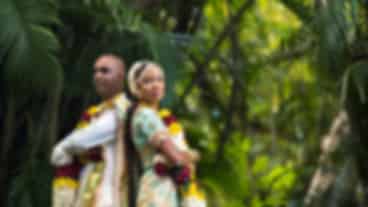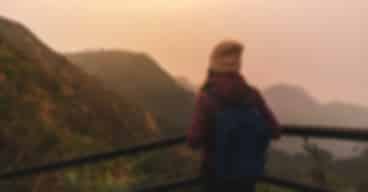Dzukou Valley: A Serene Haven
Author
Amirthavarshini
Updated Date
January 16, 2025
Read
7 minutes

Beauty lies in the rolling hills, winding streams, and tangled wild growths. One such beautiful location is the Dzukou Valley, which is located on the border of Nagaland and Manipur. It is an important highlight that adorns Northeast India. Dzukou Valley, which is also spelled Dzükou Valley, is nestled at a height of 2,452 metres above sea level. The place looks extra beautiful in the summer, with vivid green hillocks contrasting with the bright blue skies and vibrant flowers. During the winter season, the place turns into a tropical retreat. The valley freezes with a white blanket of snow over it.

grasslands of Dzukou valley in Nagaland
More about Dzukou Valley
Walk on the multicoloured carpets of blooming flowers. Take a look at the smiling Dzuko lily, which can be spotted only in the Dzukou Valley. These rare flowers begin to bloom during the onset of monsoon season, the first two weeks of July. You can hike around the valley while looking at the amazing vistas and scenic beauty. One more important factor about the valley is that it is an undiscovered spot for foreigners. Known only by the locals, the place is usually less crowded than other scenic spots in the Seven Sister States.

Enjoying the nature from the top of the cliff
How to get to Dzukou Valley from Nagaland?
One can reach Dzukou Valley from Manipur and Nagaland as well. However, since there are no amenities and restaurants in the trail of Manipur, this way is not preferred to reach the valley. Also, the trekking trail from Manipur is much more strenuous, with crooked roads. You can still take the route from Manipur if you are assisted by a proper local guide who knows the route and the necessary equipment. Hence, the visitors from Manipur initially drive to Nagaland and then proceed to the valley.
One can reach Dzukou Valley easily from Kohima, the capital city of Nagaland. Take a private bus or a train to reach the capital city. The nearest rail station to Kohima is in Dimapur. At about 20 kilometers from Kohima lie the two towns of Jakhama and Viswema. It is from these towns that one can approach the Dzukou Valley.
How to approach the Valley
- The approach that you take to reach the valley is totally dependent on your fitness and ability.
- The trek from Jakhama to Dzukou Valley is narrow and steep. But it takes less time when compared to the Viswema approach.
- However, the Viswema trek is gradual but takes longer than Jakhama.
- The best possible solution is to enter the Dzukou valley by the Viswema approach and exit via the Jakhama trail.
Reaching Jakhama or Viswema from Kohima
In order to get into a bus to reach the two towns from Kohima, take a shared taxi from the Network Travels AOC bus depot. You can spot several yellow vans and Sumos lined up there. Ask one of the men sitting around, and you’ll soon be directed towards the right vehicle. It will cost around 40 INR to get to Jakhama, whereas it will cost 50 INR to get to Viswema. The only disadvantage of the shared taxi is that they move only if the vehicle gets full. This may roughly take 30 to 45 minutes of your time.

The rest house at the Dzukou valley
The Viswema approach to reach Dzukou Valley
While heading to the Dzukou valley by the Viswema trail, you will have to drive through a motorable road for 8 km. Then, the road slopes up gradually. From there, walk along the trekking trail for around 3 hours. You can also hire a taxi or cab from the highway to the end of the motorable road. However, the fare would be as high as 1500 INR.
Once you get to Viswema, walk along the road for 45 minutes to reach the starting point of the valley. There is a resting spot at this place where you can have a peaceful lunch break. Then, take a nature walk for two hours through the valley. You will get to a beautiful rest house at the end. You can stretch your legs and enjoy the hug from nature there
Quick tip!
You can also try hitching a ride on the motorable road. Since there’s construction work going on at the end of this road on all days, a high frequency of construction workers travelling in big trucks is quite common. You can jump into one of those trucks passing by to reach the trekking trail.
The Jakhama approach to reach Dzukou Valley
Though this approach is much more challenging than the Viswema approach, adventure lovers and thrill-seekers can opt on this path. The steep path with rough-hewn stone will give a test to your legs. However, you can choose this path to head down from the valley as it is less slippery than Viswema.
If you are heading upwards to the Dzukou valley from Jakhama, take a ride through the motorable road that extends for 4 kilometres. Then take an adventurous walk through the steep trail for 5 hours. Eventually, the path merges with the trail from Viswema.
Visiting Dzukou Valley – The budget
Entry fee
- Local people from surrounding villages – 20 INR
- other Indians – 50 INR
- For foreigners – 100 INR
Where to stay in Dzukou Valley
There’s a basic rest house in the Dzukou valley. It offers two refugee camp-like dorms and five other private rooms with basic amenities. It is advised to take your own mattress
- Dorm cost – 50 INR
- Rest house – 300 INR per room
- Other amenities such as mattresses, blankets, and pillows are of extra charge
- Breakfast and lunch options are also available.

beautiful sunset view after trekking
Stay options at Kohima
Kohima is a graceful city with lively bazaars, churches, war cemetery and beautiful natural assets. There are several pleasant places to stay before you head to the Dzukou valley.
- Pine hotel in Kohima offers basic rooms ranging from 1000 INR per night.
- Morung Lodge homestay which is located next to the pine hotel is a charming place with friendly staff. It costs around 1000 INR per person for a dorm.
Take a fun-filled trek with your friends to the most beautiful trekking trail in the North East. The beauty of Dzukou Valley is hard to express with adjectives. The only way to know about the charm of Dzukou Valley is to be there and feel the bliss. Roaming around with the aroma of scented flowers and soft grasslands is a feeling that everyone should experience. So now, head to the PickYourTrail website and start planning your trip to Nagaland right away!
If you are looking for a perfect international trip, PickYourTrail offers you the best International tour packages where you can customize your itinerary.
Frequently Asked Questions
Dzukou Valley is a picturesque valley in northeastern India that is known for its breathtaking natural beauty and diverse flora.
Trekking routes lead to the valley from two main entry points: Viswema Village in Nagaland and Zakhama Village in Manipur. The trek usually takes a few hours, depending on where you start and the weather.
The best time to visit is generally from June to September, when the valley is covered in vibrant flowers, particularly the rare Dzukou Lily, and the weather is pleasant.
The valley itself has no lodging. Visitors often camp in tents, carrying their camping equipment, or stay in nearby villages before or after the trek.
Yes, Inner Line Permits (ILP) are required for visitors to enter Nagaland and can be obtained from the Nagaland House in Delhi, Kolkata, Guwahati, or Dimapur.
Recommended articles for you
Discover Packages


Need help in planning?
Talk to our Travel Experts






























